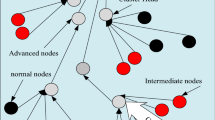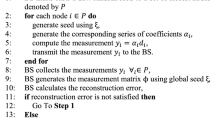Abstract
Sensor node energy constraint is considered as an impediment in the further development of the Internet of Things (IoT) technology. One of the most efficient solution is to combine between compressive sensing (CS) and routing techniques. However, this combination faces many challenges that makes it an attractive point for research. This paper proposes an Efficient Multi-hop Cluster-based Aggregation scheme using Hybrid CS (EMCA-CS) for IoT based heterogeneous wireless sensor networks (WSNs). EMCA-CS efficiently combines between CS and routing protocols to extend the network lifetime and reduces the reconstruction error. EMCA-CS includes the following: a new algorithm to partition the field into various hexagonal cells (clusters) and based on multiple criteria, selects a node from each cluster as cluster head (CH). Each CH will then compress its cluster data using hybrid CS method. Also, a new Grey Wolf based algorithm to create optimal path for CHs to deliver the compressed data to base station (BS) and a CSMO-GWO algorithm to optimize the CS matrix construction process is introduced. Moreover, a new Grey Wolf and reversible Greedy based Reconstruction Algorithm is proposed to recover the actual data. The simulation results indicate that the performance of the proposed work exceeds the existing baseline techniques in terms of prolonging WSN lifetime, reducing the power consumption and reducing normalized mean square error.

























Similar content being viewed by others
References
Donoho, D. L. (2006). Compressed sensing. IEEE Transactions on Information Theory, 529(4), 1289–1306.
Cands, E. J. (2006). Compressive sampling. In Proceedings of the international congress of mathematicians (Vol. III, pp. 1433–1452). Madrid, Spain.
Meenu, R., Sanjay, B., & Dhok, R. B. (2018). DeshmukhA systematic review of compressive sensing: Concepts, implementations and applications. IEEE Access, 6, 4875–4894.
Lv, C., Wang, Q., Yan, W., & Shen, Y. (2016). Energy-balanced compressive data gathering in wireless sensor networks. Journal of Network and Computer Applications, 61, 102–114.
Khedr, A. M. (2015). Effective data acquisition protocol for multi-hop heterogeneous wireless sensor networks using compressive sensing. Algorithms, 8(4), 910–928.
Omar, D. M., Khedr, A. M., & Agrawal, Dharma P. (2017). Optimized clustering protocol for balancing energy in wireless sensor networks. International Journal of Communication Networks and Information Security (IJCNIS), 9(3), 367–375.
Khedr, A. M., & Omar, Dina M. (2015). SEP-CS: Effective routing protocol for heterogeneous wireless sensor networks. Ad Hoc and Sensor Wireless Networks, 26, 211–232.
Omar, D. M., & Khedr, A. M. (2018). ERPLBC: Energy efficient routing protocol for load balanced clustering in wireless sensor networks. Ad Hoc and Sensor Wireless Networks, 42, 145–169.
Aziz, A., Singh, K., Osamy, W., & Khedr, A. M. (2019). Effective algorithm for optimizing compressive sensing in IoT and periodic monitoring applications. Journal of Network and Computer Applications,. https://doi.org/10.1016/j.jnca.2018.10.013.
Aziz, A., & Singh, K. (2018). Lightweight security scheme for Internet of Things. Wireless Personal Communications, 104(2), 577–593.
Singh, K., Singh, K., Le, H. S., & Aziz, A. (2018). Congestion control in wireless sensor networks by hybrid multi-objective optimization algorithm. Computer Networks, 138, 90–107.
Osamy, W., Khder, A. M., Aziz, A., & Elsawy, A. (2018). Cluster-tree routing based entropy scheme for data gathering in wireless sensor networks. IEEE Access, 6, 77372–77387.
Aziz, A., Singh, K., Osamy, W., & Khedr, A. M. (2019). Effective algorithm for optimizing compressive sensing in IoT and periodic monitoring applications. Journal of Network and Computer Applications, 126, 12–28.
Heinzelman, W., Chandrakasan, A., & Balakrishnan, H. (2000). Energy efficient communication protocol for wireless microsensor networks. In Proceedings of the 33rd Annual Hawaii International Conference (pp. 3005–3014).
Luo, C., Wu, F., & Sun, J. (2013). An efficient compressive data gathering routing scheme for large-scale wireless sensor networks. Computers and Electrical Engineering, 39(6), 1935–1946.
Nguyen, M. T., Teague, K. A., & Rahnavard, N. (2016). CCS: Energy-efficient data collection in clustered wireless sensor networks utilizing block-wise compressive sensing. Computer Networks, 106, 171–185.
Chen, S., Zhao, C., Wu, M., Sun, Z., Zhang, H., & Leung, V. C. M. (2016). Compressive network coding for wireless sensor networks: Spatio-temporal coding and optimization design. Computer Networks, 108, 345–356.
Luo, J., Xiang, L., & Rosenberg, C. (2010). Does compressed sensing improve the throughput of wireless sensor networks? In IEEE International Conference on Communications (ICC) (pp. 1–6).
Xiang, L., Luo, J., & Vasilakos, A. (2011). Compressed data aggregation for energy efficient wireless sensor networks. In 2011 8th annual IEEE communications society conference on sensor, mesh and ad hoc communications and networks (Vol. 11, pp. 46–54).
Mardani, A., Jusoh, A., Nor, K., Khalifah, Z., Zakwan, N., & Valipour, A. (2015). Multiple criteria decision-making techniques and their applications–a review of the literature from 2000 to 2014. Economic Research-Ekonomska Istraživanja, 28(1), 516–571.
Heinzelman, W. B. (2000). Application-specific protocol architectures for wireless networks, Microsystems Technology Laboratories. Cambridge: Massachusetts Institute of Technology.
Jerbi, W., Guermazi, A., & Trabelsi, H. (2016). O-LEACH of routing protocol for wireless sensor networks. In 2016 13th International Conference on Computer Graphics, Imagin and Visualization (CGiV), Beni Mellal (pp. 399–404).
Aderohunmu, F. A., Deng, J. D., & Purvis, M. K. (2011). A deterministic energy-efficient clustering protocol for wireless sensor networks. In Proceedings of seventh IEEE international conference on intelligent sensors, sensor networks and information processing (pp. 341–346).
Salim, A., Osamy, W., & Khedr, A. (2014). IBLEACH: Intra-balanced LEACH protocol for wireless sensor networks. Wireless Network, 20(6), 1515–1525.
Al-Zubaidi, A., Ariffin, A., & Al-Qadhi, A. (2018). Enhancing the stability of the improved-LEACH routing protocol for WSNs. Journal of ICT Research and Applications, 12(1), 1–13.
Smaragdakis, G., Matta, I., & Bestavros, A. (2004). SEP: A stable election protocol for clustered heterogeneous wireless sensor networks In Proceeding of the international workshop on SANPA.
Mittal, N., Singh, U., & Singh Sohi, B. (2017). A stable energy efficient clustering protocol for wireless sensor networks. Wireless Networks, 23, 809–1821.
Kumar, S., Kant, S., & Kumar, A. (2015). Enhanced threshold sensitive stable election protocol for heterogeneous wireless sensor network. Wireless Personal Communications, 85, 2643–2656.
Aziz, A., Salim, A., & Osamy, W. (2013). Adaptive and efficient compressive sensing based technique for routing in wireless sensor networks. In Proceedings of INTHITEN (IoT and its Enablers) conference (pp. 3–4).
Chong, L., Feng, W., Jun, S., & Chang, C. (2009). Compressive data gathering for large-scale wireless sensor networks. In Proceedings of the 15th annual international conference on mobile computing and networking, MobiCom ’09 (pp. 145–156), New York, NY, USA.
Xiang, L., Luo, J., & Vasilakos, A. (2011). Compressed data aggregation for energy efficient wireless sensor networks. In 2011 8th annual IEEE communications society conference on sensor, mesh and ad hoc communications and networks (pp. 46–54).
Haupt, J., Bajwa, W., & Rabbat, M. (2012). Compressed sensing for networked data. IEEE Signal Processing Magazine, 25, 603–611.
Duarte, M., Sarvotham, S., Wakin, M., Baron, D., & Baraniuk, R. (2005). Joint sparsity models for distributed compressed sensing. In Proceedings of the workshop on signal processing with adaptative sparse structured representations (SPARS).
Jin, W., ShaoJie, T., Baocai, Y., & Yang, X. (2013). Data gathering in wireless sensor networks through intelligent compressive sensing. Digital Signal Processing, 23, 1539–1548.
Luo, C., Wu, F., & Sun, J. (2010). Efficient measurement generation and pervasive sparsity for compressive data gathering. IEEE Transactions on Wireless Communications, 9(12), 3728–3738.
Xie, R., & Jia, X. (2014). Transmission-efficient clustering method for wireless sensor networks using compressive sensing. IEEE Transactions on Parallel and Distributed Systems, 25(3), 806–815.
Nguyen, M. T. (2013). Minimizing energy consumption in random walk routing for Wireless Sensor Networks utilizing compressed sensing. In Proceedings of the 2013 8th international conference on system of systems engineering, Maui, HI (Vol. 2–6, pp. 297–301). New York: IEEE.
Salim, A., & Osamy, W. (2015). Distributed multi chain compressive sensing based routing algorithm for wireless sensor networks. Wireless Networks, 21, 1379–1390.
Ejaz, A., Yaqoob, I., Gani, A., Imran, M., Guizani, M., Rabbat, M., et al. (2016). CInternet-of-things-based smart environments: state of the art, taxonomy, and open research challenges. IEEE Wireless Communications, 23, 10–16.
Mirjalili, S., Mirjalili, S., & Lewis, A. (2014). Grey Wolf optimizer. Advances in Engineering Software, 69, 46–61.
Liu, H., Hua, G., Yin, H., & Xu, Y. (2018). An intelligent grey Wolf optimizer algorithm for distributed compressed sensing. Computational Intelligence and Neuroscience, 20(6), 1–10.
Kumara, V., Kumara, V., Sandeep, D., Yadava, S., Barikb, R., Tripathic, R., et al. (2018). Multi-hop communication based optimal clustering in hexagon and voronoi cell structured WSNs. International Journal of Electronics and Communications, 93, 305–316.
Houy, N., & Tadenuma, K. (2009). Lexicographic compositions of multiple criteria for decision making. Journal of Economic Theory, 144, 1770–1782.
Needell, D., & Tropp, J. A. (2009). COSAMP: Iterative signal re-covery from incomplete and inaccurate samples. Applied and Computational Harmonic Analysis, 26(3), 301–321.
Wei, D., & Olgica, M. (2009). Subspace pursuit for compressive sensing signal reconstruction. IEEE Transactions on Information Theory, 55(5), 2230–2249.
Du, X., Cheng, L., & Chen, D. (2014). A simulated annealing algorithm for sparse recovery by \(l_0\) minimization. Neurocomputing, 131, 98–104.
Tropp, J., & Gilber, A. (2007). Signal recovery from random measurements via orthogonal matching pursuit. IEEE Transactions on Information Theory, 53(14), 4655–4666.
Burak, N., & Erdogan, H. (2013). Compressed sensing signal recovery via forward-backward pursuit. Digital Signal Processing, 23, 1539–1548.
Chartrand, R., & Yin, W. (2008). Iteratively reweighted algorithms for compressive sensing. In IEEE international conference on acoustics (pp. 3869–3872). Las Vegas, NV: Speech and Signal Processing.
University of Southern California (USC) http://anrg.usc.edu/www/tutornet/.
Intel Lab Data,http://db.csail.mit.edu/labdata/labdata.html.
Duarte-Carvajalino, J. M., & Sapiro, G. (2009). Learning to sense sparse signals: Simultaneous sensing matrix and sparsifying dictionary optimization. IEEE Transactions on Image Processing, 18(7), 1395–1408.
Abolghasemi, V., Jarchi, D., & Sanei, S. (2010). A robust approach for optimization of the measurement matrix in compressed sensing. In 2010 2nd international workshop on cognitive information processing (pp. 388–392). Elba, Italy.
Abolghasemi, V., Ferdowsi, S., Makkiabadi, B., & Sanei, S. (2010). On optimization of the measurement matrix for compressive sensing. In 18th European signal processing conference (pp. 427–431), Aalborg.
Tropp, J., & Gilber, A. (2007). Signal recovery from random measurements via orthogonal matching pursuit. IEEE Transactions on Information Theory, 53(14), 4655–4666.
Author information
Authors and Affiliations
Corresponding author
Additional information
Publisher's Note
Springer Nature remains neutral with regard to jurisdictional claims in published maps and institutional affiliations.
Rights and permissions
About this article
Cite this article
Aziz, A., Osamy, W., Khedr, A.M. et al. Grey Wolf based compressive sensing scheme for data gathering in IoT based heterogeneous WSNs. Wireless Netw 26, 3395–3418 (2020). https://doi.org/10.1007/s11276-020-02265-8
Published:
Issue Date:
DOI: https://doi.org/10.1007/s11276-020-02265-8




